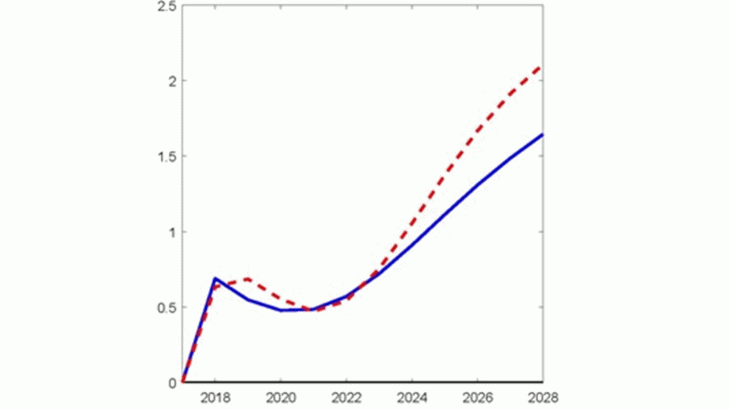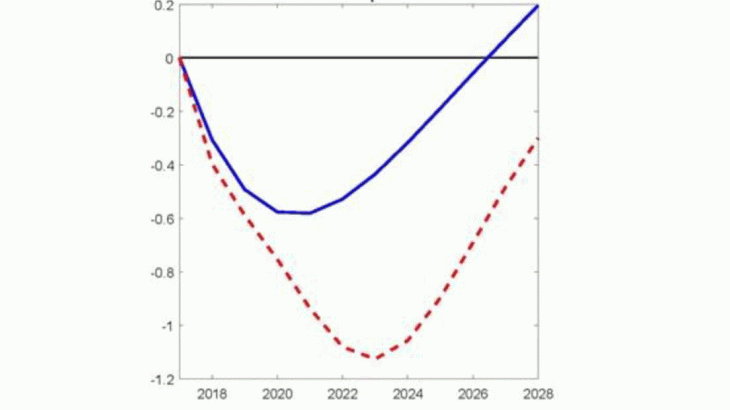Note : Responses of GDP (solid blue line) and private investment (dashed red line) to an increase in public investment compensated by labour and consumption taxation equivalent to 1% of GDP. Real variables in percentage deviation from the steady state.
Since the onset of the Great Recession, fiscal policy issues have been at the core of policy and academic debate. Indeed, disappointing growth performance since 2010, coupled with large fiscal debt in many countries, shifted the discussion on fiscal measures to compositional aspects (see Auerbach and Gorodnichenko, 2017, intervention at the Jackson Hole 2017 Economic Policy Symposium and Chapter 4 of the last IMF WEO, 2017). In particular, budget-neutral measures – i.e. changes in the composition of fiscal revenue and spending leaving the ex-ante government budget balance unchanged – have been proposed and discussed intensively in recent policy meetings of the IMF, the OECD and the G20.
This column shows that budget-neutral fiscal interventions can indeed be growth enhancing but benefits and costs are not equally distributed across the population. Also the timing matters: if changes are done in periods of accommodative monetary policy, the inequality costs are reduced and positive macroeconomic effects are amplified.
Simulations show that budget-neutral measures can stimulate growth
Using simulations from an international macro model calibrated to the US economy (the Global Integrated Monetary and Fiscal Model) in which the government budget is characterised by consumption, investment and transfers on the spending side and by consumption, labour and capital taxation on the revenue side, we test all possible budget-neutral fiscal changes. We first focus on the composition of the spending and revenue side separately and then we mix the two sides of the fiscal budget. Multiple compositional changes are expansionary. Among all the measures considered (fiscal devaluation or an increase in government investment financed by a decrease in government consumption, for example), it turns out that an increase in government investment fully compensated ex ante by an increase in both labour and consumption taxes is the most growth-enhancing measure, when considering both short and long-term horizons. Such change, normalised to a budget-neutral increase in government investment equivalent to 1 pp of GDP, increases the level of real GDP by 0.7 pp after one year and by 1.6 pp after ten years. The hump-shaped response in the first 4 years, shown in Figure 1, is due to the presence of real and nominal frictions in the model. Importantly, and differently from other budget-neutral measures, the immediate gain in growth could act as an incentive for policy-makers to implement this kind of strategy.
As can be seen in Figure 1, investment is the main transmission channel of this budget-neutral measure to the economy. The increase in government investment boosts private investment (up 2.1% after 10 years) through reasonable crowding-in effects (we calibrate the output elasticity to the public capital stock to be equal to 0.04). As a result, this additional capital spending leads to an increase in labour demand that puts upward pressure on wages and inflation. The monetary authority responds to this evolution of prices by tightening monetary policy, thus appreciating the nominal exchange rate on impact. As a result, the trade deficit initially increases but then slowly reverts. Additionally, in the medium run, the reform results in the consolidation of the budget balance as a consequence of the GDP and tax revenue increase.

